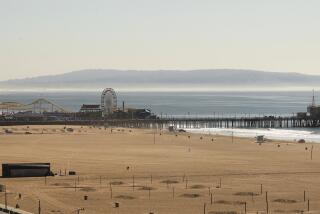Momentum on Bolsa Chica
- Share via
Among Orange County’s most intractable issues is the conflict between quality of life and the demands of growth and development. The long-running dispute over the future of the Bolsa Chica mesa and wetlands reflects this tension.
Over the years, fresh developments have fueled old passions, shifting for a time the focus of the debate to one new proposal or another. For longtime residents, it would have been possible to leave the area and return with reasonable certainty that the conflict had altered little in the intervening years.
Now it is possible to envision a resolution to a dispute that can be thought of in terms of the span of generations. A solution is now possible because the fundamental question arising from an unpopular development proposal is squarely on the table. If a property owner can’t develop land, what alternative is there but to sell it to those who want it to remain open space?
An agreement already has been made on the most controversial portion of the area, now that the state has purchased the wetlands. That leaves only the mesa, and recent events have pushed the issue in the direction of a resolution. An end to this conflict is in sight perhaps for the first time.
On one side, there are the imperatives for the developer. A decision in November by the California Coastal Commission that limited development to a perceived “upper tier” of the 230-acre mesa made building increasingly unattractive for the landowner, Signal Landmark. That commission decision is being challenged, but it has had a way of making other things happen. For example, Assemblyman Tom Harman (R-Huntington Beach) has sought $25 million in state funds to put toward the purchase price.
The Huntington Beach City Council has recognized a compelling interest. It has indicated a willingness to try to buy the mesa. Meanwhile, the Bolsa Chica Land Trust, an influential player in the litigation over the size and character of development on the mesa, now is leading the initiative to buy the land.
For all parties, getting the fate of the wetlands resolved had made it easy to focus on the mesa. The building proposals were scaled back over time from an original proposal for a marina, hotels and 5,700 homes to something much more restricted.
For the developer, what remains has become so limited that considering a sale inevitably has become more attractive. For development opponents, it is time to put all cards on the table. Is the real objective blocking any building on the mesa, and if so, is that objective worth whatever it takes to assemble a fair purchase price for the land?
The issue of cost now will have to be resolved. Those who wish to see the purchase go through will need to reckon with fiscal reality. Signal Landmark may prove a willing seller if its efforts to develop the land remain frustrated through the complicated approval process and litigation. However, the question will be, at what price?
The council and environmentalists have been banking on receiving funds from the state’s $2.1-billion Proposition 12 parks bond measure. However, the amount that actually may be available to fund the mesa purchase no doubt will prove a test of the buyers’ ability to raise other money.
The state administers hundreds of millions of dollars from the initiative but has said it is unlikely it would fund the entire purchase price. There are, after all, other worthy claims on these dollars around the state.
Any attempt to reach a fair purchase price also will have to factor in the original price of $20 million in 1970, and the owner’s stated expenditures on trying to develop the land, estimated at about $90 million.
Negotiations will take place in an atmosphere of momentum for resolution. Open space purchase has become a way of resolving such land-use disputes in Laguna Beach and elsewhere in the last decade.
The opportunity exists if the parties resolve to make it happen.
More to Read
Sign up for Essential California
The most important California stories and recommendations in your inbox every morning.
You may occasionally receive promotional content from the Los Angeles Times.













